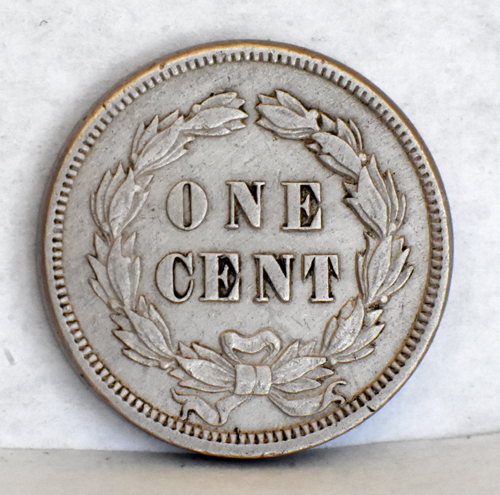Indian Head Small Cent
1859 Copper-Nickel Laurel Wreath
1860 to 1864 Copper-Nickel Oak Wreath
1864 to 1909 Bronze
Oak Wreath
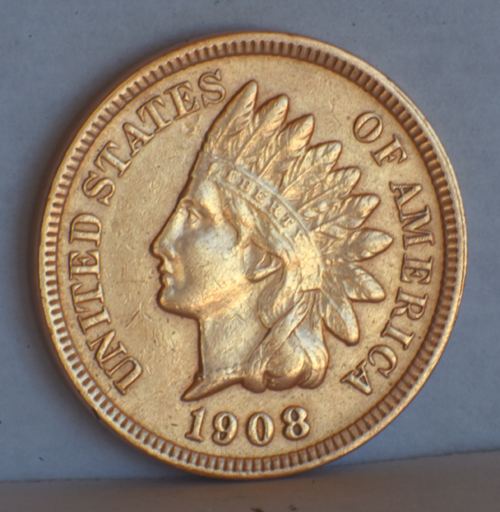 |
The Indian Head penny has been arguably the most famous of all U.S. coins, its only rival being the Morgan dollar. Although the composition of the coin remained the same as the flying eagle cent for the first five years, the new design was accepted by the public and when the copper content was increased to 95% in 1864, the coin was embraced widely and remained relatively unchanged for the next 45 years. Two issues are rare and quite valuable: the 1877 and the 1909 S. | 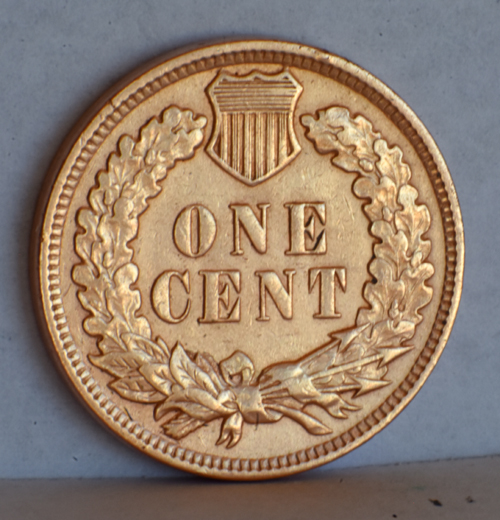 |
| This coin does appear to be uncirculated and is worth about $40 if it qualifies for the grade of 60. I now have a complete set of these coins, including the 1877 example, which is an XF 40 grade worth $2250. My 1909 S is worth about $475. | This is the reverse of the coin at left. | |
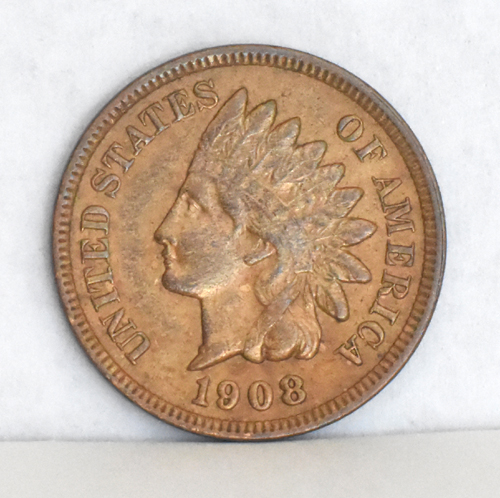 |
The design of the Indian Head penny is actually a representation of Liberty wearing an Indian headdress, not a real native American. It was designed by James Longacre and some of the coins minted in late 1864 and after 1864 bear his intial but it is so small that it cannot be seen without magnification. | 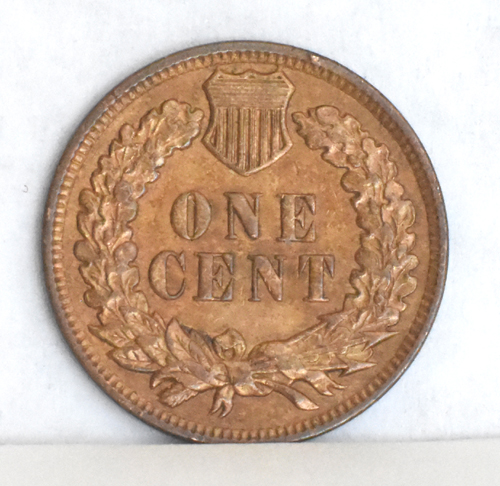 |
| This coin was sold as uncirculated, cost me $33.02 but is not worth what I paid for it because it is only an EF in my opinion. | This is the reverse of the coin at left. | |
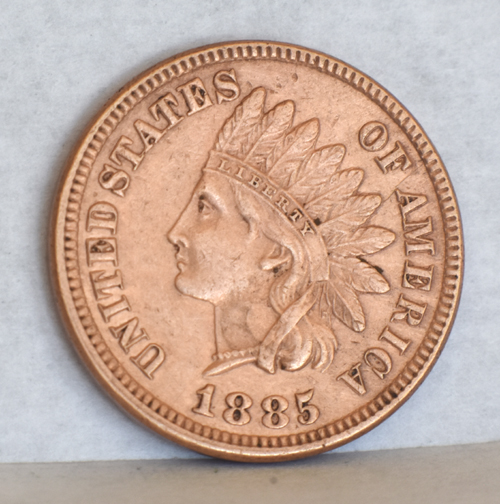 |
A minor variation after 1886 involved the direction pointed by the last feather in the headdress - Until that time, the feather pointed slightly upward from the C. This can be seen in my two coins here and in the 1859 example below. Also, this coin and the top two above show the tiny 'L' just to the right of the place where the ribbon crosses the hair, which was put there for James Longacre, the designer of the coin. | 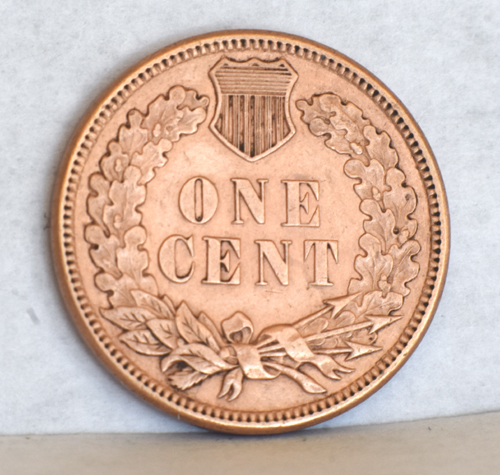 |
| This coin was bought for two different purposes but was not needed for either. I have posted it here because the color seems closer to real than the other coins above and below, probably because it has obviously been cleaned. | This is the reverse of the coin at left. The coin is difficult to grade but seems to be either an EF 40 or 45 or an AU. It is mounted in cardboard and stored in box 508. | |
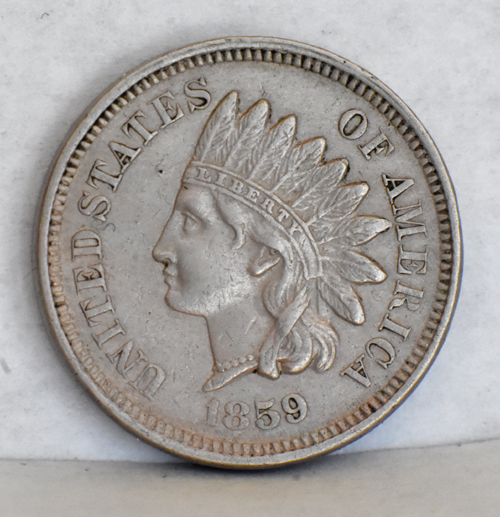 |
Prior to the issuance of the nickel five cent pieces in 1866 these coins were popularly referred to as nickels or nicks. Later, they were called white cents. |
|
| This is the Laurel Wreath penny - The composition of the coin was .88% copper and .12% nickel and the coin looked decidedly gray. This example cost me $141 and needs to be an EX 45 to justify that expense. It is difficult to say whether or not that is true without certification, which I am not inclined to do at this time. | This is the reverse of the coin at left. In 1860, a shield was added to the reverse side of the coin. | |
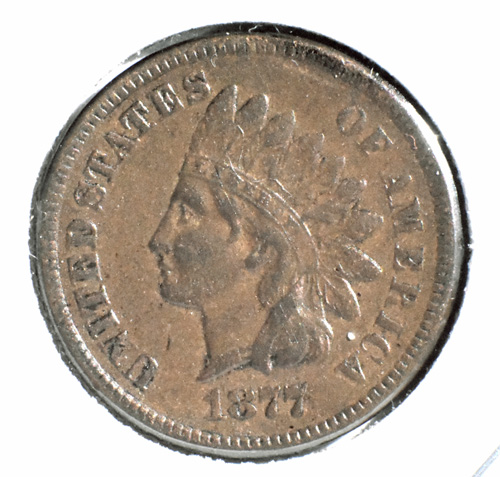 |
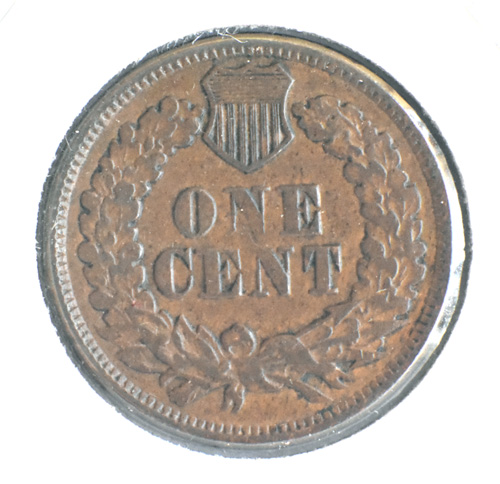 |
|
| This is the 1877 coin which I bought for exactly its value: $2250. The coin is now certified as XF 40 which justifies that price but I must admit that I was quite disappointed when I received the coin because it did not look anything like the photograph in the Ebay ad. The coin shop had listed the coin as a choice AU and had shown the coin with a different picture and never claimed to image the actual coin that was being sold. So despite being legal, this practice was a big disappointment to me and I have vowed never to buy another coin from this particular seller who obviously overgrades the coins he sells that have not been certified. | This is the reverse of the 1877 penny. It is the nicest one I have ever seen, I think, but simply does not look as good as I would like it to look for having paid that amount of money. But at least it is rare, with only 852,500 having been minted and very few survive today with this grade. And only 309,000 of the 1909 S coins were minted in that year but more are available to collectors these days and that is the reason that they are not as valuable as the 1877 issue and the reason I was able to buy one for $454. As many as 108 million Indian Head cents were made in a single year during the life of this coin. |
| 1859: January 1: Minting of Indian Head cent begins. February 14: Oregon is admitted as the 33rd U.S. state. February 27: U.S. Congressman Daniel Sickles shoots Philip Barton Key for having an affair with his wife. June 8: The discovery of the Comstock Lode in the western Utah Territory (present-day Nevada) sets off a rush of prospectors to the area. July: Pike's Peak Gold Rush begins in the Colorado Territory. August 27: Edwin Drake drills the first oil well in the United States, near Titusville, Pennsylvania, starting the Pennsylvanian oil rush. September: Joshua Abraham Norton proclaims himself "Emperor of the United States" in San Francisco and the solar storm of 1859, aka the Carrington Event, a powerful geomagnetic solar storm occurs. October 16: Militant abolitionist leader John Brown raids the Harpers Ferry Armory in Harper's Ferry, Virginia, in an unsuccessful bid to spark a general slave rebellion. October 18: Troops under Colonel Robert E. Lee overpower John Brown at the Federal arsenal. December 2: John Brown is hanged for his October 16 raid on Harpers Ferry, West Virginia. |
| 1877: January 8: Battle of Wolf Mountain: Crazy Horse and his warriors fight their last battle with the United States Cavalry in Montana. March 2: In the Compromise of 1877, the U.S. presidential election is resolved with the selection of Rutherford B. Hayes as the winner, even though Samuel J. Tilden had won the popular vote on November 7, 1876. May 5: Sitting Bull leads his band of Lakota into Canada to avoid harassment by the United States Army under Colonel Nelson Miles. May 6: Realizing that his people are weakened by cold and hunger, Chief Crazy Horse of the Oglala Sioux surrenders to United States troops in Nebraska. June 17: The Battle of White Bird Canyon: The Nez Perce defeat the U.S. Cavalry at White Bird Canyon in the Idaho Territory. August 9: The Battle of Big Hole: Near Big Hole River in Montana, a small band of Nez Percé Indians who refused government orders to move to a reservation, clash with the United States Army. The army loses 29 soldiers and the Indians lose 89 warriors in a U.S. Army victory. August 17: Arizona blacksmith F.P. Cahill is fatally wounded by Billy the Kid. Cahill dies the next day, becoming the first person killed by the Kid. September 5: Oglala Sioux chief Crazy Horse is bayoneted by a United States soldier, after resisting confinement in a guardhouse at Fort Robinson in Nebraska. November 21: Thomas Edison announces his invention of the phonograph, a machine that can record sound, considered Edison's first great invention. |
| 1908: January 3: A total solar eclipse is visible in Pacific Ocean, and is the 46th solar eclipse of Solar Saros 130. January 12: A long-distance radio message is sent from the Eiffel Tower for the first time. January 21: New York City passes the Sullivan Ordinance, making it illegal for women to smoke in public, only to have the measure vetoed by the mayor. January 24: Robert Baden-Powell's Scouting for Boys begins publication in London. The book eventually sold over 100 million copies, and effectively begins the worldwide Boy Scout movement. February 18: Japanese emigration to the United States is forbidden, under terms of the Gentlemen's Agreement of 1907. March 4: The Collingwood school fire near Cleveland, Ohio, kills 174. March 29 – French aviator Henri Farman made the world's first flight with a passenger, Léon Delagrange. May 26: At Masjed Soleyman in southwest Persia, the first major commercial oil discovery in the Middle East is made. The rights to the resource are quickly acquired by the United Kingdom. June 28: An annular solar eclipse was visible from Central America, North America, Atlantic Ocean and Africa, and was the 33rd solar eclipse of Solar Saros 135. June 30: The Tunguska event or "Russian explosion" near the Podkamennaya Tunguska River in Krasnoyarsk Krai, Siberia, Russian Empire, is believed to have been caused by the air burst of a large meteoroid or comet fragment, at an altitude of 3–6 mi above the Earth's surface. July 27–28: The 1908 Hong Kong typhoon sinks the passenger steamer Ying King, causing 421 deaths. September 17: At Fort Myer, Virginia, Thomas Selfridge becomes the first person to die in an airplane crash. The pilot, Orville Wright, is severely injured in the crash but recovers. October 1: Official launch of Henry Ford's Ford Model T automobile, the first having left the Ford Piquette Avenue Plant in Detroit, Michigan, on September 27. The initial price is set at US$850. November 6: Western bandits Butch Cassidy and the Sundance Kid are supposedly killed in Bolivia, after being surrounded by a large group of soldiers. There are many rumors to the contrary however, and their grave sites are unmarked. November 28: A mine explosion in Marianna, Pennsylvania, kills 154 men, leaving only one survivor. December 28: The 7.1 Mw Messina earthquake shakes Southern Italy with a maximum Mercalli intensity of XI (Extreme), killing between 75,000 and 200,000. According to NASA reports, 1908 was the coldest recorded year since 1880. A 40,000-year-old Neanderthal boy skeleton is found at Le Moustier in southwest France, by Otto Hauser. |
